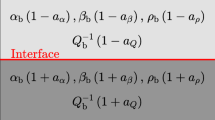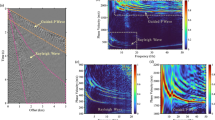Abstract
Attenuation factor (1/Q) is an important indicator that is sensitive to hydrocarbon-bearing reservoirs. In attenuative media, seismic wave velocity is complex and frequency dependent, and 1/Q appears in the imaginary part of wave velocity. Focusing on the real part of complex wave velocity in attenuative media, we present new-parameterized P- and S-wave velocities, in which a maximum P-wave attenuation factor (\(1/Q_\mathrm{Pm}\)) is involved. Using solutions of Zoeppritz equations, we derive approximate PP- and PSV-wave reflection coefficients and anelastic impedances (AEI) as a function of \(1/Q_\mathrm{Pm}\), and we employ an empirical relationship to replace the S-wave attenuation factor with \(1/Q_\mathrm{Pm}\) in the derivation of PSV-wave reflection coefficient. Using the derived reflection coefficients and AEI, we establish an inversion approach and workflow of utilizing PP- and PSV-wave seismic amplitudes to estimate elastic parameters (i.e. P- and S-wave moduli, density) and anelastic parameter (i.e. \(1/Q_\mathrm{Pm}\)). Inputting different frequency components of PP- and PSV-wave seismic wave amplitudes, a model-based least-squares (LS) algorithm is employed to implement the deconvolution for estimating the PP- and PSV-wave AEI of different dominant frequencies and incidence angles, and the joint inversion of PP- and PSV-wave AEI for elastic parameters and attenuation factor is implemented using a Newton method. We employ synthetic seismic data of different signal-to-noise ratios (SNR) to verify the stability and robustness of the established inversion approach, and we finally apply the approach to real datasets acquired over a hydrocarbon reservoir. It illustrates that stable elastic parameters and attenuation factors may be estimated; and combining the inverted elastic parameters and attenuation factor, we may realize the reliable identification and interpretation of hydrocarbon reservoirs.
Article Highlights
-
PP- and PSV-wave reflection coefficients and anelastic impedances are derived in terms of P- and S-wave moduli, density, and P-wave attenuation factor at the characterize frequency.
-
Approach of joint inversion of PP- and PSV-wave seismic datasets for estimating P and S-wave moduli, density and P-wave attenuation factor based on first- and second-order derivatives of anelastic impedances is established.
-
Tests on synthetic and real datasets imply the proposed inversion approach can be used as a valuable tool for generating reliable results of elastic properties and attenuation factor for hydrocarbon reservoir characterization.















Similar content being viewed by others
References
Aki K, Richards PG (2002) Quantitative seismology. University science books, California
Chapman M, Liu E, Li XY (2006) The influence of fluid sensitive dispersion and attenuation on AVO analysis. Geophys J Int 167(1):89–105
Chen H (2020) Seismic frequency component inversion for elastic parameters and maximum inverse quality factor driven by attenuating rock physics models. Surv Geophys 41:835–857
Chen H, Innanen KA, Chen T (2018) Estimating P-and S-wave inverse quality factors from observed seismic data using an attenuative elastic impedance. Geophysics 83(2):R173–R187
Chen H, Li J, Innanen KA (2020) Nonlinear inversion of seismic amplitude variation with offset for an effective stress parameter. Geophysics 85(4):R299–R311
Connolly P (1999) Elastic impedance. Lead Edge 18(4):438–452
Dvorkin J, Nur A (1993) Dynamic poroelasticity: A unified model with the squirt and the Biot mechanisms. Geophysics 58(4):524–533
Dvorkin J, Nolen-Hoeksema R, Nur A (1994) The squirt-flow mechanism: macroscopic description. Geophysics 59(3):428–438
Dvorkin J, Mavko G, Nur A (1995) Squirt flow in fully saturated rocks. Geophysics 60(1):97–107
Dvorkin JP, Mavko G (2006) Modeling attenuation in reservoir and nonreservoir rock. Lead Edge 25(2):194–197
IIkelle LT, Amundsen L (2005) Introduction to petroleum seismology, investigations in geophysics, Society of Exploration Geophysicists, Tulsa, OK.
Innanen KA (2011) Inversion of the seismic AVF/AVA signatures of highly attenuative targets. Geophysics 76(1):R1–R14
Köhn D (2011) Time domain 2D elastic full waveform tomography. PhD thesis, University of Kiel
Kurt H (2007) Joint inversion of AVA data for elastic parameters by bootstrapping. Comput Geosci 33(3):367–382
Larsen JA (1999) AVO inversion by simultaneous PP and PS inversion. Master’s thesis, University of Calgary
Lines L, Wong J, Innanen K, Vasheghani F, Sondergeld C, Treitel S, Ulrych T (2013) Research note: experimental measurements of Q-contrast reflections. Geophys Prospect 62(1):190–195
Margrave GF (2013) Q tools: Summary of CREWES software for Q modelling and analysis. the 25th Annual Report of the CREWES Project
Margrave GF, Stewart RR, Larsen JA (2001) Joint PP and PS seismic inversion. Lead Edge 20(9):1048–1052
Martins JL (2006) Elastic impedance in weakly anisotropic media. Geophysics 71(3):D73–D83
Mavko G, Dvorkin J, Walls J (2005) A theoretical estimate of S-wave attenuation in sediment. In: SEG Technical Program Expanded Abstracts 2005, Society of Exploration Geophysicists, pp 1469–1472
Mavko G, Mukerji T, Dvorkin J (2009) The rock physics handbook: tools for seismic analysis of porous media. Cambridge University Press, Cambridge
Moradi S, Innanen KA (2015) Scattering of homogeneous and inhomogeneous seismic waves in low-loss viscoelastic media. Geophys J Int 202(3):1722–1732
Moradi S, Innanen KA (2016) Viscoelastic amplitude variation with offset equations with account taken of jumps in attenuation angle. Geophysics 81(3):N17–N29
Morozov IB (2011) Anelastic acoustic impedance and the correspondence principle. Geophys Prospect 59(1):24–34
Whitcombe DN (2002) Elastic impedance normalization. Geophysics 67(1):60–62
Zhang F, Li X (2015) Exact elastic impedance tensor for isotropic media. Sci China Earth Sci 58(8):1350–1360
Zhang Z (2010) Assessing attenuation, fractures, and anisotropy using logs, vertical seismic profile, and three-component seismic data: heavy oilfield and potash mining examples. PhD thesis, University of Calgary
Zong Z, Yin X, Wu G (2013) Elastic impedance parameterization and inversion with young’s modulus and poisson’s ratioei with young and poisson. Geophysics 78(6):N35–N42
Acknowledgements
This work was sponsored by Shanghai Sailing Program and Natural Science Foundation of Shanghai, and it was also supported by the Fundamental Research Funds for the Central Universities. We thank the sponsors of CREWES for continued support. This work was also funded by NSERC (Natural Science and Engineering Research Council of Canada) through the grant CRDPJ 461179-13. We also acknowledge the Canada First Research Excellence Fund, and the Mitacs Accelerate grant Responsible Development of Unconventional Hydrocarbon Reserves. The SINOPEC Key Lab of Multi-Component Seismic Technology is thanked for providing the processed real datasets.
Author information
Authors and Affiliations
Corresponding author
Additional information
Publisher's Note
Springer Nature remains neutral with regard to jurisdictional claims in published maps and institutional affiliations.
Appendices
Appendix A: Elastic Parameters and Incidence Angles Expressed Using Scatterings in Anelastic Media
Following Moradi and Innanen (2016), we rewrite frequency-dependent P- and S-wave velocities, P- and S-wave incidence and transmission angles, and density of top and bottom layers as
Combining Eqs. (22) and (11), we express perturbation in incidence angles as
Appendix B: Elastic Parameters and Incidence Angles Expressed Using Scatterings in Anelastic Media
Substituting expressions of P- and S-wave velocities and moduli of upper and lower layers to solutions of Zoeppritz equations for PP and PSV waves, we first obtain reflection coefficients of PP and PSV waves after some algebra, which are similar to reflection coefficients that are derived for PP and PSV waves in elastic media, as
where \({{{g}}}=\frac{{\mathcal {U}}}{{\mathcal {M}}}\). We observe that effects of elastic properties and attenuation factor are hidden in the reflectivities \(\frac{{\varDelta }{\mathcal {M}}}{{\mathcal {M}}}\) and \(\frac{{\varDelta }{\mathcal {U}}}{{\mathcal {U}}}\), and we next approximately express \(\frac{{\varDelta }{\mathcal {M}}}{{\mathcal {M}}}\) and \(\frac{{\varDelta }{\mathcal {U}}}{{\mathcal {U}}}\) as
Substituting Eq. (25) into Eq.(24), we obtain final expressions of frequency-dependent PP- and PSV-wave reflection coefficients as
where
and \(\gamma =\frac{\mu }{M}\). We conclude that in Eq.26 the effects of elastic parameters and attenuation factor on PP- and PSV-wave reflection coefficients may be separated explicitly.
Rights and permissions
About this article
Cite this article
Chen, H., Moradi, S. & Innanen, K.A. Joint Inversion of Frequency Components of PP- and PSV-Wave Amplitudes for Attenuation Factors Using Second-Order Derivatives of Anelastic Impedance. Surv Geophys 42, 961–987 (2021). https://doi.org/10.1007/s10712-021-09649-1
Received:
Accepted:
Published:
Issue Date:
DOI: https://doi.org/10.1007/s10712-021-09649-1




